Art & Exhibitions
Germany’s Best Summer Art Escape
Outside Bielefeld, eight artists give a lesson in public sculpture. Amble at will.
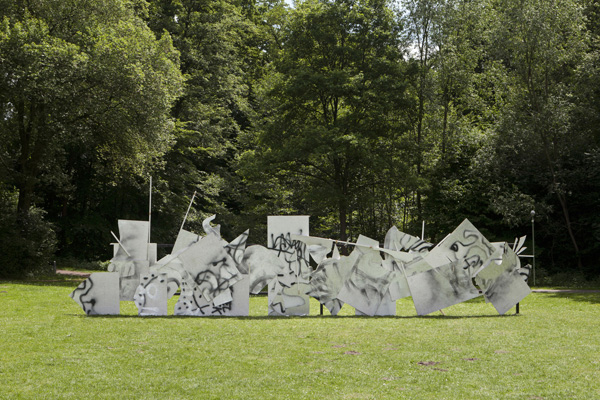
Outside Bielefeld, eight artists give a lesson in public sculpture. Amble at will.

Alexander Forbes

Opening Vor Ort (On Site), a public art exhibition of international artists in Sennestadt, a sub-municipality of the already-obscure German city of Bielefeld, an official recounted an exchange he had with a concerned citizen as the pieces were installed. “We always have money for this kind of shit,” the budgetary-minded individual said sarcastically. “Yes, we do,” he recalled responding emphatically, waxing on the need to spend some time with the art and the artists in order to get what they were up to.

Christian Falsnaes, Front (2014)
Photo: Philipp Ottendörfer, Courtesy Vor Ort
Indeed, a fairly geriatric bunch gathered to see the works by David Adamo, Awst and Walther, Michael Beutler, Andreas Bunte, Christian Falsnaes, Manfred Pernice, Anre Schmitt, and Katerina Seda unveiled looked fairly nonplussed at the opening’s get-go. Many, it seemed, would have preferred to see another traditional interpretation of mildly abstracted plop art that had formed the city’s previous editions of Skulptur aktuell (Sculpture Today). But, after just minutes on this latest parcours, curated by the Kunstverein Bielefeld’s Thomas Thiel, most had changed their minds.
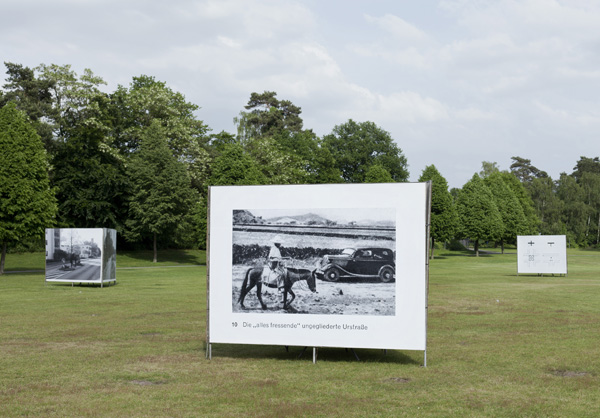
Arne Schmitt, Die autogerechte Stadt (Rüchführung) (2014)
Photo: Philipp Ottendörfer, Courtesy Vor Ort
The works on view in Sennestadt are, across the board, quite strong. But its their context and execution, which illuminates the importance of the project. Designed in the 1950s by Hans Bernhard Reichow, the city is a modernist utopia of urban planning, its roads and pathways mimicking the human circulatory system in their layout—arteries for cars around the city’s perimeter with a vast green space strung with capillaries of human walkways. The scheme is directly reflected in Arne Schmitt’s piece Die autogerechte Stadt (2014), titled for Reichow’s method of separating cars, humans, and bikes on different roadways, often not visible from one another. Schmitt printed various archival materials regarding city planning, his own photographs of roadways, and a schematic of a human lung on three-sided billboards typically used for political advertisements as if to inspire pride in and proselytizing for this seemingly enlightened yet quickly forgotten urban development ideal. The piece is an important anchor in an ongoing struggle for Sennestadt-pride, due to the high percentage of refugees among its initial inhabitants and subsequent second-class status in comparison to Bielefeld-proper. “[Bielefelders] wouldn’t normally come here,” one Sennestädter told me. She hoped Vor Ort might change that.
While Schmitt might turn skeptics into contemporary art converts on a slow-working subliminal level, Danish artist Christian Falsnaes spared no time or subtlety in his crowd-favorite performance-cum-sculpture Front (2014) (see above video). The work is one in an ongoing series of participatory performances in which Falsnaes and his audience make a piece together. Starting with a cube, painted white (he calls it a projection surface), Flasnaes asks the group to walk around it in a circle, then pulls out four, tossing them black spray paint and tells them to go to town. Two older women went the abstract route, one man got a bit street-arty, while another—in what can only be called a tantalizingly symptomatic admission of post-Fordist life—sprayed the logo of the printing press for which he presumably worked. Four more repeated the process in silver spray. Four studio assistants demolished the box using jigsaws. And the whole community nailed the fragments onto a nearby frame. Meanwhile, many among the formerly grumpy lot could be over heard arguing like so many critics in near-perfect art parlance over just what the piece was about. Of course, that very occurrence was largely the point.
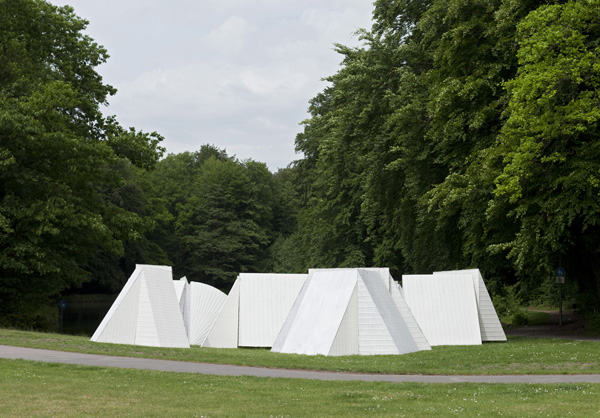
Michael Beutler, Keilhaus-Camp für Enten, Keilhütte (2014)
Photo: Philipp Ottendörfer, Courtesy Vor Ort
Other works were more traditional in their approach. Michael Beutler—who is also currently showing at the Bielefelder Kunstverein—erected a tent city out of plastic foil and metal framing on the edge of the Sennestadt pond, which recall ongoing debates about ongoing the influx of refugees, now mainly from North Africa to Germany. Only the pond’s ducks are able to enter the narrow openings at the tents’ bases or fly through gaps in their tops.
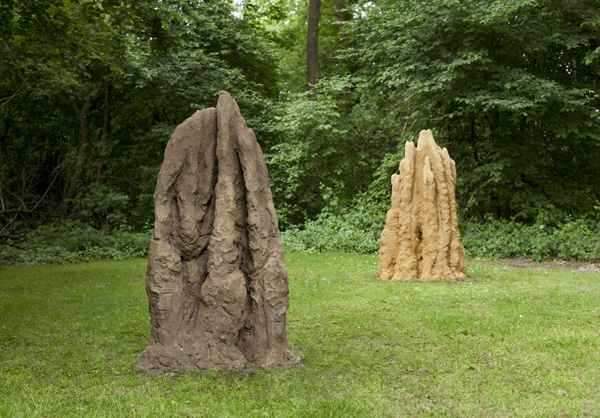
David Adamo, Untitled (Sennestadt) (2014)
Photo: Philipp Ottendörfer, Courtesy Vor Ort
David Adamo’s untitled piece sees a trio of termite mounds crop up from the ground in a quiet clearing beside one of Reichow’s walkways. The clay mounds are easily passed by as naturally occurring phenomenon should one not recognize that Bielefeld is north of the methane-producing insects’ natural habitat.
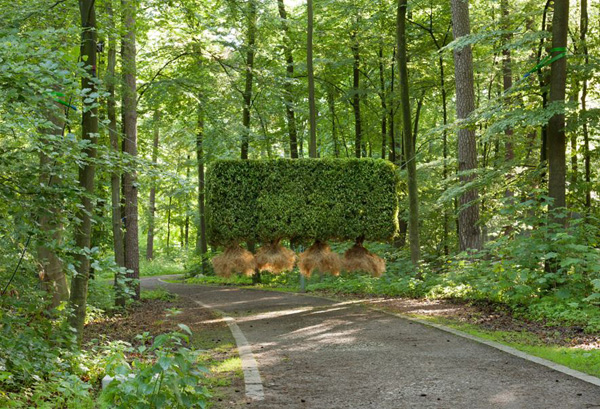
Awst and Walther, Ground to Sky (2014)
Photo: Philipp Ottendörfer, Courtesy Vor Ort
Vor Ort’s most successful piece, Welsh-German artist duo Awst and Walther’s Ground to Sky (2014), fell somewhere in the middle. (It also happened to be the only one not specifically commissioned for the project but rather pulled from their recent exhibition at Berlin’s PSM.) The hedge of four boxwoods hangs precariously suspended above and blocking a wooded foot and bike path, its roots and increasingly body becoming dried out and yellowed. It is equal parts readymade and Juddian minimalist sculpture. Its historical traces carry from the hedge’s use in primitive agriculture as the first fencing-off of human food sources from the rest of the animal kingdom, to bourgeois settlements that use hedges’ greenery to hide the beefier metal barriers that separate one person’s putting green from another’s pool, to climate change.
For such a minimal gesture, the work is seriously affective—and curiously far more so in this open-air setting than in was in the gallery in March. Even during the artists’ explanation of the work, one helmet-clad man insisted on bursting through its middle, twice. Two weeks later, unidentified vandals torched a good two-thirds of the hedge, leaving only its charred, spindly branches.
Bielefeld is a 2½ hour train ride from Berlin or a 1 hour, 45 minute train ride from Cologne. Sennestadt is most easily reached by taxi from the Bielefeld Hauptbahnhof in 15 minutes.Vor Ort runs until October 19. For more information about programming and events throughout the summer click here.